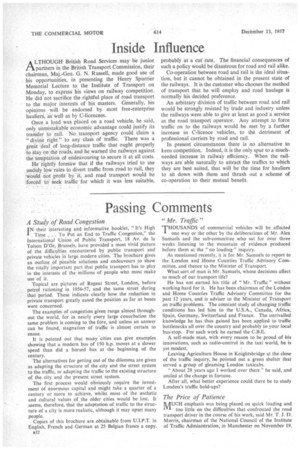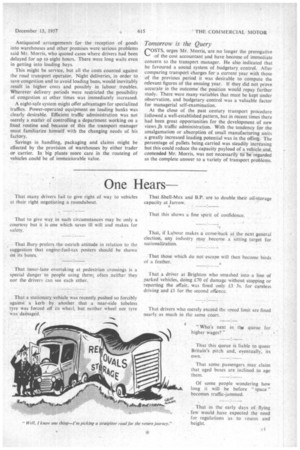Passing Comments
Page 42

Page 43

If you've noticed an error in this article please click here to report it so we can fix it.
A Study of Road Congestion "Mr. Traffic"
I N their interesting and informative booklet, "It's High Time . . . To Put an End to Traffic Congestion," the International Union of Public Transport, 18 Av. de la Toison D'Or, Brussels, have provided a most vivid picture of the difficulties encountered by public transport and private vehicles in large modern cities. The brochure gives an outline of Possible solutions and endeavours to Show the vitally important part that public transport has to play in the interests of the millions of people who must make use of it.
Topical are pictures of Regent Street, London, before petrol rationing' in 1956-57, and the same street during that period. These indicate clearly how the reduction in private transport greatly eased the position as far as buses were concerned.
The examples of congestion given range almost throughout the world, for in nearly every large conurbation the same problem is coming to the fore, and unless an answer can be found, stagnation of traffic is almost certain to ensue.
It is pointed out that many 'cities can give examples showing that a modern bus of 150 h.p. moves at a slower speed than did a horsed bus at the beginning of the century.
The alternatives for getting out of the dilemma are given as adapting the structure of the city and the street system to the traffic, or adapting the traffic to the existing structure of the city and the present street system.
The first process would obviously require the investment of enormous capital and might take a quarter of a century or more to achieve, whilst most of the esthetic and cultural values of the older cities would be lost. It seems, therefore, that the adaptation of traffic to the structure of a city is more realistic, although it may upset many people.
Copies of this brochure are obtainable from U.I.P.T. in English, French and German at 25 Belgian francs a copy. e32 THOUSANDS of commercial vehicles will be affected
one way or the other by the deliberations of Mr. Alex Samuels and the sub-committee who sat for over three weeks listening to the mountain of evidence produced before them at the "no loading" inquiry.
As mentioned recently, it is for Mr. Samuels to report to the London and Home Counties Traffic Advisory Committee, and thence to the Minister of Transport.
What sort of man is Mr. Samuels, whose decisions affect so much of our transport life?
He has not earned his title of "Mr. Traffic" without working hard for it. He has been chairman of the London and Home Counties Traffic Advisory Committee for the past 12 years, and is adviser to the Minister of Transport on traffic problems. The constant study of changing traffic conditions has led him to the U.S.A., Canada, Africa, Spain, Germany, Switzerland and France. The unrivalled knowledge he has thus gained has been applied to traffic bottlenecks all over the country and probably to your local bus-stop. For such work he earned the C.B.E.
A self-made man, with every reason to be proud of his innovations, such as radio-control in the taxi world, he is yet modest.
Leaving Agriculture House in Knightsbridge at the close of the traffic inquiry, he pointed out a green shelter that served a group of gleaming London taxicabs.
"About 28 years ago I worked over there" he said, and smiled at the change in fortune.
After all, what better experience could there be to study London's traffic hold-ups?
The Price of Patience
MUCH emphasis was being placed on quick loading and too little on the difficulties that confronted the road transport driver in the course of his work, said Mr. T. J. D. Morris, chairman of the National Council of the Institute of Traffic Administration, in Manchester on November 19.
Antiquated arrangements for the reception of goods into warehouses and other premises were serious problems said Mr. Morris, who quoted cases where drivers had been delayed for up to eight hours. There were long waits even in getting into loading bays.
This might be service, but all the costs counted against the road transport operator. Night deliveries, in order to save congestion and to avoid loading bans, would inevitably result in higher costs and possibly in labour troubles. Wherever delivery periods were restricted the possibility of congestion at other times was immediately increased.
A night-safe system might offer advantages for specialized traffics. Power-operated equipment on loading banks was clearly desirable. Efficient traffic administration was not merely a matter of controlling a department working on a fixed routine and because of this the transport manager must familiarize himself with the changing needs of his factory.
Savings in handling, packaging and claims might be effected by the provision of warehouses by either trader or carrier. In big plants more care in the routeing of vehicles could be of immeasurable value.
Tomorrow is the Query
rOSTS, urges Mr. Morris, are no longer the prerogative of the cost accountant and have become of immediate concern to the transport manager. He also indicated that he favoured a sound system of budgetary control. After comparing transport charges for a current year with those of the previous period it was desirable to compute the relevant figures of the ensuing year. If they did not prove accurate in the outcomethe position would repay further study. There were many variables that must be kept under observation, and budgetary control was a valuable factor for managerial self-examination.
At the close of the past century transport procedure followed a well-established pattern, but in recent times there had been great opportunities for the development of new views fn traffic administration. With the tendency for the amalgamation or absorption of small manufacturing units a greatly increased loading potential was in the offing. The percentage of pallets being carried was steadily increasing but this could reduce the capacity payload of a vehicle and, contended Mr. Morris, was not necessarily to be regarded as the complete answer to a variety of transport problems.




















































































































